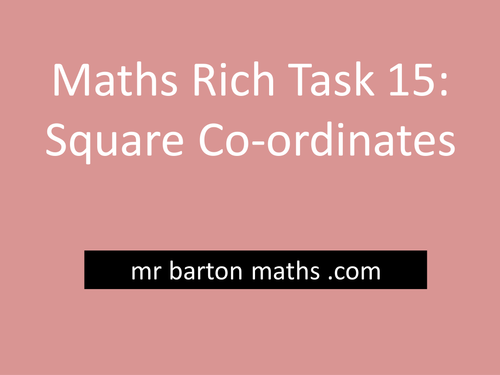


Something went wrong, please try again later.
Thank you for publishing your resource. It has been selected to be featured in <a href="https://www.tes.com/teaching-resources/collections/secondary-maths/"> a new secondary maths collection</a>.
Very nice rich task from the legendary Mr Barton where students investigate coordinates relating to squares, and have to note any patterns they notice. This task could easily be extended to other shapes such as triangles or quadrilaterals and allow students to pose and answer their own problems.
If you know the co-ordinates of two adjacent corners, investigate how can you find the other two?<br /> <br /> If you know the co-ordinates of two opposite corners, investigate how can you find the other two?<br /> <br /> How can we construct a square when we are given the centre and one corner?<br /> <br /> Do these all work if some of the co-ordinates are negative?<br /> <br /> Can you use a vectors approach?<br /> <br /> How about an algebraic approach?<br /> <br /> From NRICH:<br /> Decide whether any of the collections of points below form a square.<br /> If so, which ones? <br /> Can you do this without plotting the points on a grid? <br /> <br /> 1. (8,3), (7,8), (2,7), (3,2) <br /> 2. (3,3), (7,4), (8,8), (4,7) <br /> 3. (16,19), (18,22), (21,20), (19,17) <br /> 4. (4,20), (21,19), (20,2), (3,3) <br /> <br /> Explain how you decided.<br /> <br /> Extend this investigation into rectangles<br /> <br /> How about other quadrilaterals?<br /> <br /> If you are given three coordinates, work out how to determine if they will define a right angle.<br /> <br /> Can you work out the areas of each of your squares?<br />
Report this resourceto let us know if it violates our terms and conditions.
Our customer service team will review your report and will be in touch.
